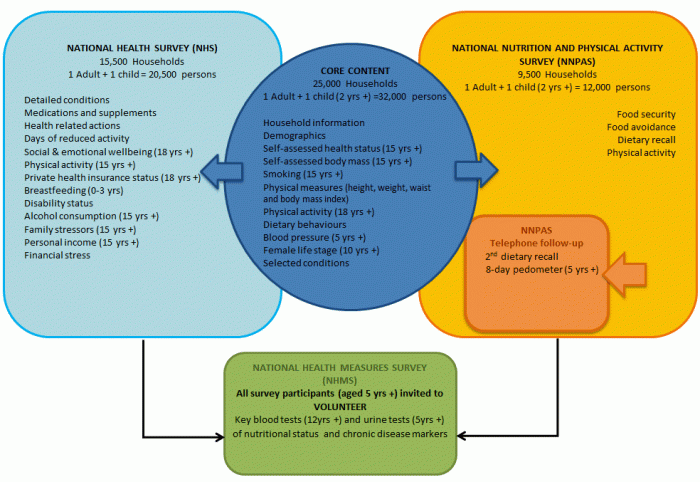This publication is the second release of information from the National Health Measures Survey (NHMS), the biomedical component of the 2011–13 Australian Health Survey (AHS). Around 11,000 respondents aged 5 years and over across Australia voluntarily provided blood and/or urine samples, which were tested for a range of chronic disease and nutrient biomarkers. This publication focuses on the test results for nutrients, including folate, iodine, Vitamin B12, iron and Vitamin D. More detailed data for each of these nutrients is available in the tables in the Data downloads section below.
Iodine
- The World Health Organization (WHO) considers a population iodine deficient if the median urinary iodine concentration is less than 100 μg/L. They also recommended that no more than 20% of the population have iodine concentrations below 50 μg/L.
- The NHMS results showed that the Australian population was iodine sufficient in 2011–12, with a population median of 124.0 μg/L. Likewise, 12.8% had a concentration less than 50 μg/L.
- Iodine levels varied across Australia, with adults in Western Australia having the highest median iodine levels in 2011–12 (157.4 μg/L) and Tasmanians the lowest (108.0 μg/L).
Women of childbearing age
- The vast majority of women of childbearing age had sufficient folate levels in 2011–12, which is important for preventing neural tube defects (NTDs) in babies, most notably spina bifida. Overall, less than 1% of women aged 16–44 years had red cell folate levels in the at risk range for NTDs (less than 906 nmol/L).
- Women aged 16–44 years also had adequate levels of Vitamin B12 in 2011–12, with an average of 359.7 pmol/L, which is well above the WHO cut-off for Vitamin B12 deficiency (150 pmo/L).
- However, levels of iodine were relatively low for women of childbearing years. In 2011–12, one in every five (18.3%) women of childbearing age had an iodine deficiency (defined as less than 50 µg/L) and nearly two thirds (62.2%) had an iodine level less than 150 µg/L, which is the recommended level for all women who are pregnant, breastfeeding or considering pregnancy.
Vitamin D
- Just under one in four Australian adults (23%) had a Vitamin D deficiency, which comprised 17% with a mild deficiency, 6% with a moderate deficiency and less than 1% with a severe deficiency.
- Vitamin D levels varied considerably by season, with rates of deficiency being much lower in summer (14%) and much higher in winter (36%).
- In winter, rates of Vitamin D deficiency were particularly high in the south eastern states of Victoria (49%), ACT (49%) and Tasmania (43%) compared with the northern states of Queensland (15%) and the Northern Territory (17%).
- One in twenty Australian adults (5%) were taking Vitamin D supplements in 2011–12. As expected, those who took Vitamin D supplements had lower levels of Vitamin D deficiency than those who did not take supplements (7% compared with 23%).
